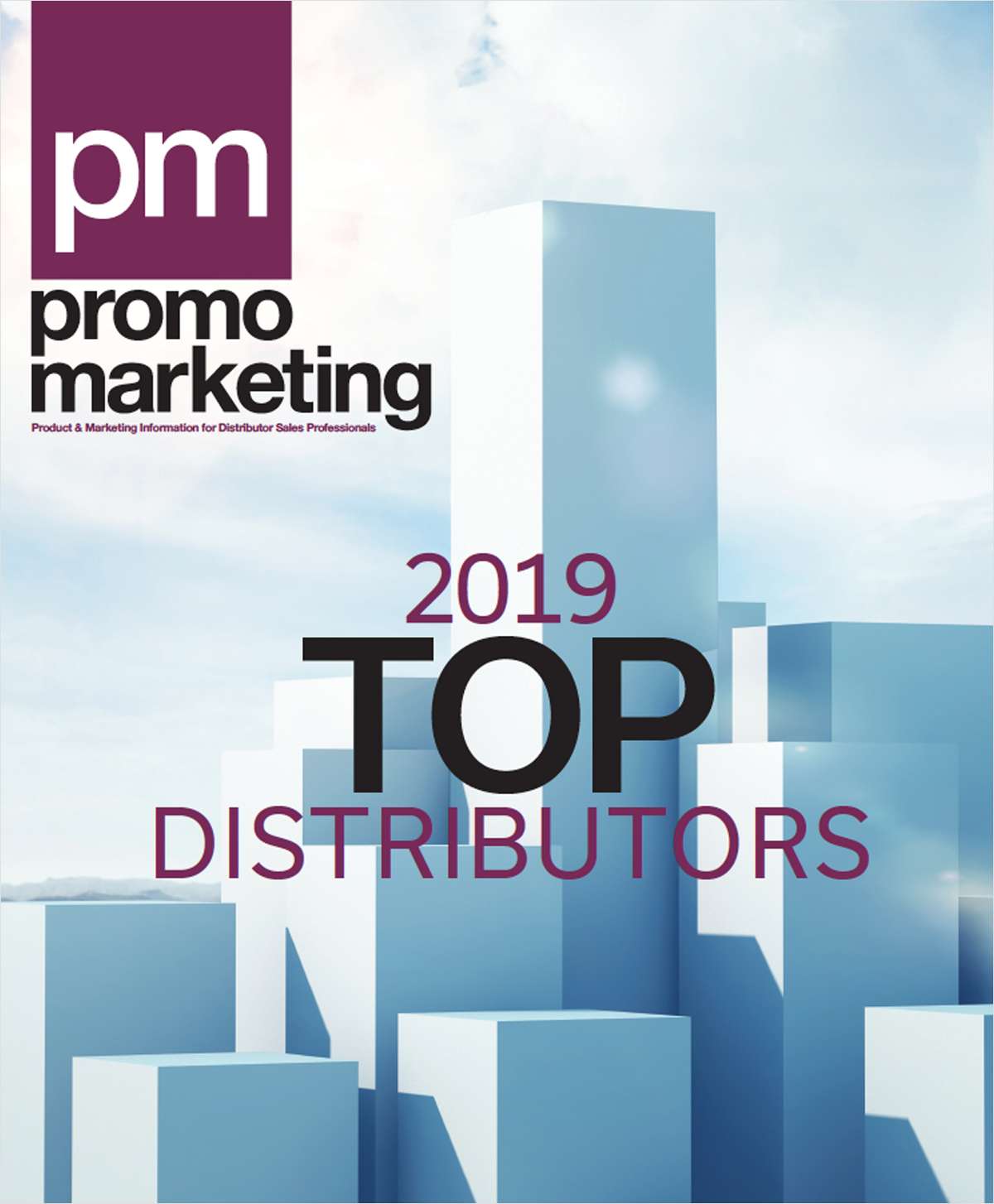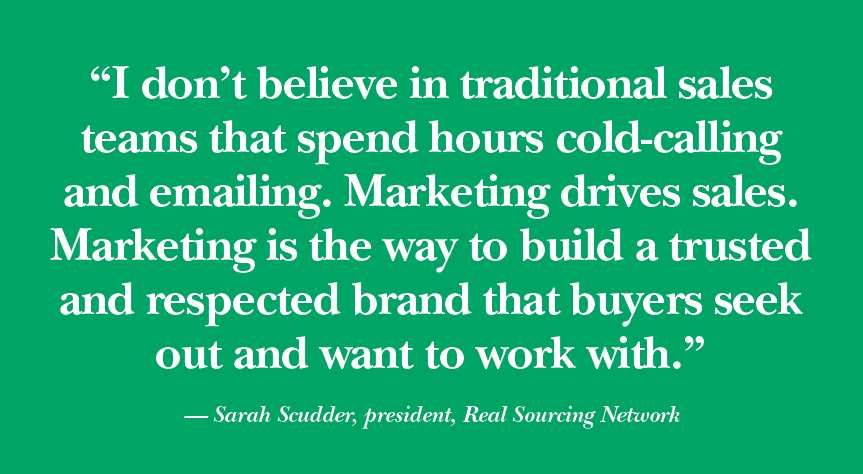As part of our 2019 Top Distributors list, we took a look at some of the industry’s fastest-growing promo distributors. Winbrook, a $22 million print company based in Billerica, Mass., was one of them, increasing its promotional products sales 42.86 percent from $3.5 million in 2017 to $5 million last year. Real Sourcing Network LLC, a smaller company based in New York City, grew its fledgling promotional products sales from $48,000 in 2017 to $380,000 last year—a 744.44 percent increase. We talked to Mike Champoux, sales director for Winbrook, and Sarah Scudder, president of Real Sourcing Network (RSN), to find out how the two companies did it—and what other promo businesses can learn from their success.
Read on to see what they said, or download the list here for the full Top 30 Fastest Growing Distributors ranking. And don’t miss our interviews with five other fast-growing distributors from the list.
Strategic strength
In the baseball world, we often hear about the merits of five-tool players. In the promo universe, it seems as if companies need to be 5,000-tool contributors who conceive and implement amazing ideas that consistently attract business. Since Winbrook and RSN have garnered such esteem, Champoux and Scudder wish to welcome more successful practitioners into their fold, and believe that is possible to do if people become even more dedicated students of marketing’s advantages, technology’s benefits and clients’ needs.
“I don’t believe in traditional sales teams that spend hours cold-calling and emailing,” Scudder said. “Marketing drives sales. Marketing is the way to build a trusted and respected brand that buyers seek out and want to work with. Since my first day with RSN, I’ve focused on creating and executing a marketing plan.”
Now in her 10th month with the company, Scudder gladly elaborated on that strategy. To get the word out about RSN’s promo offerings, Scudder set a course that involved attending and sponsoring conferences, engaging in public speaking, creating numerous types of content, hosting quarterly networking events, conducting email marketing, running digital ads with calls to action, addressing website optimization, and developing a formal referral system through which noncompeting suppliers bring in business in return for compensation. Through that increased awareness, RSN has enabled Scudder to evolve as someone who relies on technology, data and vendor management to make print procurement more efficient. Having presented her with a chance to build a print and marketing service-focused software company, it has come to count its software as its value proposition, and Scudder believes that the software—which automates the sourcing and buying workflow so as to reduce cost, increase efficiencies and capture promotional item spend data—and other technological aids could serve as enviable game-changers.
“Companies work with us because of Sourceit, our print e-sourcing tool,” she said. “We are not providing design or creative consulting. We provide a tool to help stakeholders competitively bid their jobs, quickly source promotional items, capture their spend data and track supplier performance. We provide the solution for companies looking for a better way to buy promotional items.”

With respect to said goods, Champoux, who joined Winbrook in 2012 to build out and formalize its promo division, holds that as long as there has been an exchange of ideas or commodities in a population, such assets have served as important parts of the marketing mix. Those involved in the field are members of an “ever-changing profession,” he says, through which changes in market trends, product features and technologies end up compounded by domestic and global changes to the economy that he contends are attributable to causes outside their control. Since the reach and costs of digital communications and social media/internet-driven marketing have become prevalent among corporate marketers, too, he feels those components of contemporary information sharing have led to adaptations in the ad specialty value proposition, too. In other words, shifts in the overall marketing landscape have only made promotional products more valuable, which should make them easier to sell.
“Marketers must be asking themselves always, ‘How do we stand out?’ and ‘How do we convey our message in a way that will leave an impression?’” Champoux said. “Certainly, traditional media advertising still has a place in the marketing mix, as does the aforementioned social media and internet marketing and advertising. But, amid all the advertising noise, still stands the power of promotional items.
“I can see an advertisement or [internet] post, but I cannot use it,” he continued. “I cannot tangibly hold, keep, share or enjoy it. Promotional items are the constants in the marketing mix that help reinforce all of the other media. Now is probably one of the best times to expand the use of ad specialties to help marketers stand out from the online/digital crowd and be memorable.”
All systems go
In understanding and accepting Champoux’s last point, a curious individual could pose numerous questions about how to achieve and sustain success in this field. Some of the more crucial ones are certainly these: What are promotional products trends revealing about consumers, and how well are suppliers and distributors understanding and meeting those needs? What helps companies predict which concepts could take off, and which might stall? In what ways are distributors succeeding in growing their businesses, and in what ways are they falling short? What changes can people make to go from wanting to actually enjoying growth as a distributor? For each inquiry, our sources had much to offer their contemporaries.
“With the rise of online ordering to compete with sites like Amazon and Alibaba, companies are buying more labels and packaging,” Scudder stated. “Book and newspaper print sales have decreased dramatically, while packaging and labels purchases have skyrocketed. We are also seeing companies search for useful, technology-focused promotional items. Companies no longer want to give away cheap items that are likely to be thrown out.”
Champoux seconded Scudder’s assessments, noting that while certain sectors and verticals depend on inexpensive products, Winbrook elects to stray from calling on them, with selling fewer of the right items mattering far more than selling many of the wrong ones. “This [decision to be more collaborative and consultative] keeps our clients as partners and not customers,” he said.
As far as feeling fairly confident about what those business partners will want, Champoux acknowledged that though the Winbrook team takes note of how the retail world can drive promo trends, he and his colleagues do not engage in knee-jerk reactions to be first in a given category. Preferring a holistic view of a client’s promotional strategy, he feels promo products distributors who are more client-focused than they are product-focused are poised for maintaining healthy business and enjoying growth.
“In addition to that, there must be an awareness of and willingness to adapt and invest in product and/or service areas that complement and support the existing business model,” Champoux said. “Being nimble and prepared to seize acquisition opportunities or add valuable talent continues to make the best-in-class distributors desirable partners to their clients.”
Sustained growth
Regarding oversights and advances, Scudder asserted that distributors have not embraced technology enough, noting that Sourceit allows RSN stakeholders to automate a five-point process on each job to reduce costs by as much as 22 percent. That service has propelled her company to greater growth, and she believes that a good sourcing tool can help a distributorship grow through individualization. “Buyers can get creative ideas and purchase the same promotional items from many different distributors,” Scudder said. “They can’t, however, get a streamlined buying system from everyone. A sourcing tool offers value to all of the decision-makers involved, most often procurement and marketing.”
She also said tracking and providing real-time data and spend classifications, along with an emphasis on marketing over selling, are keys to success. “Become a thought leader in your space by providing relevant and useful information,” she said, suggesting writing articles, hosting events, attending conferences and leveraging LinkedIn as some means to market oneself.
“It is at times of transition where we often shake off bad habits or non-productive actions and uncover opportunities for growth,” Champoux said of the ever-present fear of change. “My most satisfying moments as a professional in this industry have come as a result of pushing the boundaries and sometimes taking an educated, strategic leap of faith. Not every effort yields the target results, but a consistent practice of looking for growth opportunities and being ready to strike at the right ones has kept me and our company moving forward.”
View the full 2019 Top Distributors list (including a separate list of the fastest-growing distributors) here, or click here for stats, trends and analysis from the list.




